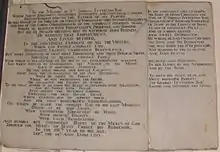Sir Thomas Lyttelton, 4th Baronet
Sir Thomas Lyttelton, 4th Baronet, of Frankley, in the County of Worcester (1686 – 14 September 1751), was an English landowner and Whig politician who sat in the House of Commons from 1721 to 1741. He held office as one of the Lords of the Admiralty from 1727 to 1741.
Early life
Lyttelton was the only surviving son of Sir Charles Lyttelton, 3rd Baronet, of Frankley, in the County of Worcester, MP, and his wife Anne Temple, daughter of Thomas Temple of Frankton, Warwickshire. He married Christian Temple, daughter of Sir Richard Temple, 3rd Baronet, of Stowe, on 8 May 1708. On the death of his father in 1716, he inherited the baronetcy and Lyttelton family estates in Frankley, Halesowen, Hagley, and Upper Arley.[1]
Career
Lyttelton was elected as one of the Members of Parliament for Worcestershire at a by-election on 6 March 1721. He was returned again at the 1727 British general election and was appointed as one of the Lords of the Admiralty in 1727, holding the post until 1741. He decided not to stand again at Worcestershire at the 1734 British general election and was brought in instead for Camelford by his son in law Thomas Pitt. He did not stand at the 1741 British general election.[2]
Legacy

Lyttelton died on 14 September 1751, leaving six sons and six daughters. He was succeeded by his eldest son George Lyttelton. His second son was Charles Lyttelton, Bishop of Carlisle and antiquary. His fourth son was Lt-General Sir Richard Lyttelton, KB. His fifth son William Henry Lyttelton succeeded as 7th baronet and was created Lord Westcote (an Irish title) in 1776 and then Baron Lyttelton in 1794. His daughter Christian married Thomas Pitt, MP.
Lyttelton's brother-in-law Sir Richard Temple, 4th Baronet was created Viscount Cobham with special remainder (in default of his own heirs male) to his sister Christian and her heirs male and in default of them to the heirs male of Christian. This latter remainder took effect in 1889 when her descendant Charles, Lord Lyttelton succeeded as Viscount Cobham.
References
- Cokayne, George Edward, ed. (1900), Complete Baronetage volume 1 (1611–1625), 1, Exeter: William Pollard and Co, retrieved 23 February 2019
- "LYTTELTON, Sir Thomas, 4th Bt. (1686-1751), of Hagley Hall, Worcs". History of Parliament Online. Retrieved 18 August 2018.
- Burkes Peerage and Baronetage (1939), s.v. Cobham, Viscount
| Parliament of Great Britain | ||
|---|---|---|
| Preceded by Sir John Pakington, Bt Samuel Pytts |
Member of Parliament for Worcestershire 1721–1734 With: Sir John Pakington, Bt 1721–1727 Sir Herbert Pakington, Bt 1727–1734 |
Succeeded by Sir Herbert Pakington, Bt Edmund Lechmere |
| Preceded by Thomas Hales John Pitt |
Member of Parliament for Camelford 1734–1741 With: James Cholmondeley |
Succeeded by The Earl of Inchiquin Charles Montagu |
| Baronetage of England | ||
| Preceded by Charles Lyttelton |
Baronet (of Frankley) 1716–1751 |
Succeeded by George Lyttelton |